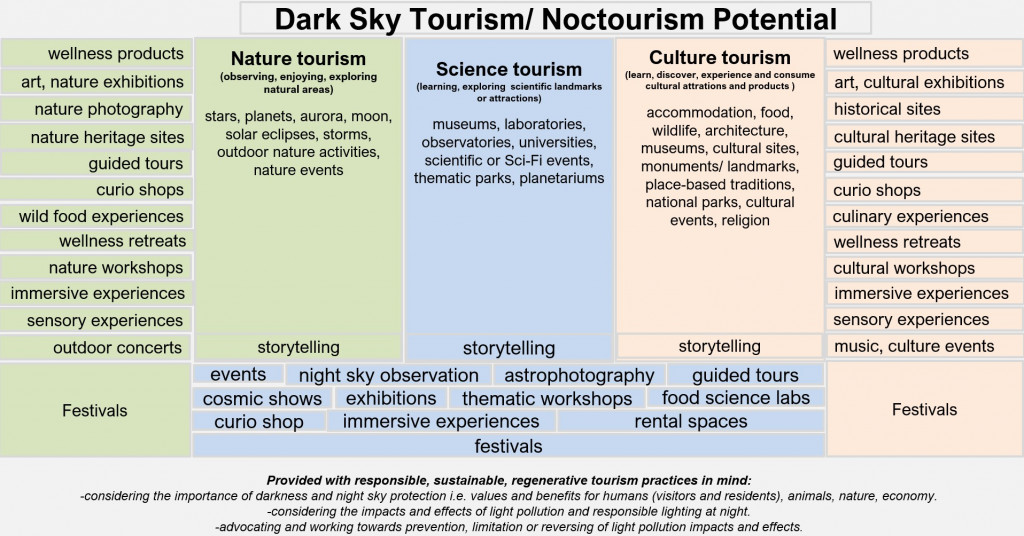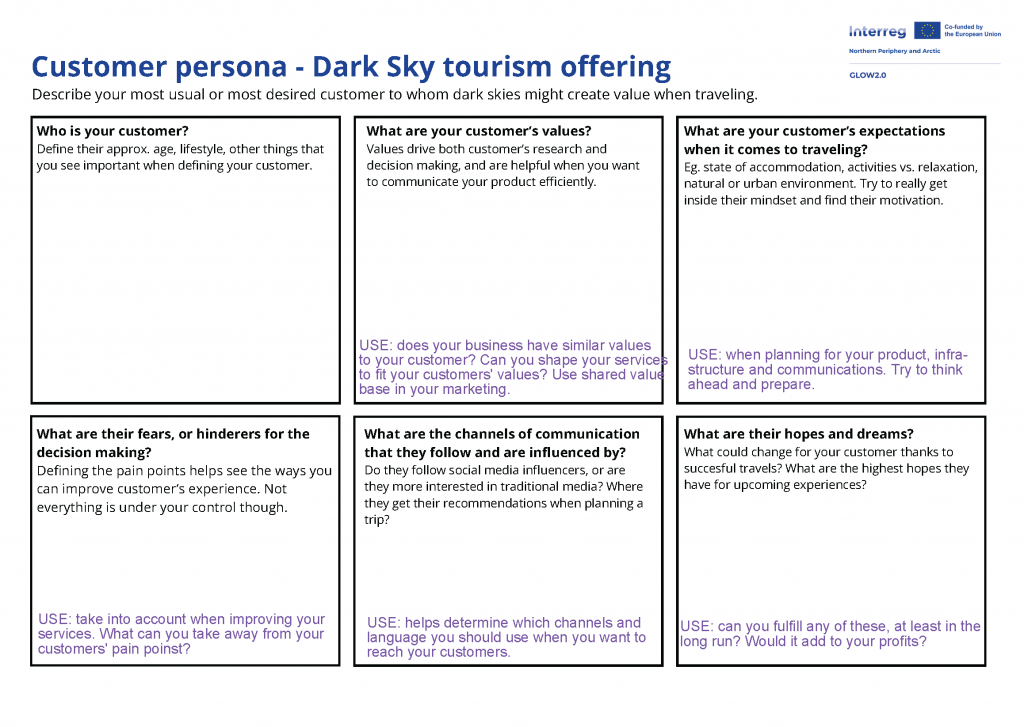Service Design for Dark Sky Tourism I: Identify your customer
Osion ääriviiva
-
Creating ideas
Dark sky tourism refers to travel focused on attractions and activities that take place between sunset and sunrise. When planning dark sky tourism in northern regions, it is important to consider the summer season and the phenomena of white nights, during which true darkness may not occur at all. In these cases, the experience may instead centre around the qualities of the natural night or an unlit sky, both of which are also considered part of dark sky tourism.
Typical activities in dark sky tourism include stargazing, astronomy-themed events, and storytelling sessions. However, it can also involve night-time hiking, canoeing or boat excursions, or enjoying a meal under the midnight sun.
With the exception of observing Northern Lights and celestial phenomena, activities in the dark are largely similar to daytime activities. The safe experience of darkness adds a new excitement to the usual experience. The activity in the dark can be primed by stories. For example, folktales, historical stories and scientific facts can enhance the experience of darkness, nature or the starry sky.
 Activity: Take a look at the graphic above. What kind of activities, services or experiences you could offer your customers? List five ideas. If you already accomplished this activity in Dark Sky Science for Tourism II, you can use that list and explore your ideas deeper.
Activity: Take a look at the graphic above. What kind of activities, services or experiences you could offer your customers? List five ideas. If you already accomplished this activity in Dark Sky Science for Tourism II, you can use that list and explore your ideas deeper.Identify your customer
Knowing your customer is important for your business. To develop better services and products that suit the needs of your customers, it is important to recognise what their wishes and dreams are, what is their lifestyle and capacity to pay, what are the tasks or problems they need to be solved with travel experiences and what they expect to gain from their travels. This leads to the most important question of all: how you as a service provider can fulfill and if possible, exceed their expectations?
Customer profiles
A customer profile, also known as a customer persona, is an important tool in service design that helps to understand service users more deeply. A customer profile (or customer persona) is a fictional but research-based character that represents a specific user group. It helps to empathize with the customer's perspective and understand their needs, motivations, and challenges. Customer profiles are usually based on user surveys, interviews or other research data, but such data is not always available. The entrepreneur's own knowledge of customers and/or that of other employees working at the company's customer interface is usually rich and in-depth and can be used as background information for customer profiles.
A customer profile usually consists some or all of the following parts:
- Name and background information: Age, profession, life situation
- Values: Values are important drivers when making a purchase
- Goals and desires: What the customer wants to achieve
- Needs and motivations: What drives the customer
- Challenges and pain points: What problems or obstacles they face
- Behavior: How they act in different situations, use of service channels
Customer segments
Customer segments are broader descriptions of groups of customers, identifiable by certain characteristics, than customer profiles. These characteristics may include, for example:
- demographic factors: age, gender, place of residence
- behaviour: e.g. purchasing habits, travel motives
- values and lifestyle criteria: sustainable tourism preferences, rainbow tourism
Customer segments are usually created through extensive research, which may include customer surveys, market research and customer data, e.g. in the form of purchase history or website analytics. A customer profile provides a unique, fictional perspective from within a broader customer segment.
Customer segments and personas not only help you design offerings with the customer in mind, they also can be used to map the customer's buying process and plan effective communication. In tourism, most of the purchase decisions are motivated by emotions in hope of fulfilling dreams, however big or small they are. Customers travel mostly in their free time, and have high expectations on their upcoming experience. Traveling is filled with different emotions that can create a powder keg or a field of opportunities for a service provider.
You will use the customer persona template in every part of these studies, and you can describe more than one customer. Personas can be valuable in other actions too; in the picture below we have marked down some examples on how to utilise your customer personas in everyday business.

If available, it is good to peruse ready made customer segments of your region as a base for your customer persona. Below you can find customer segmentations for Finland, Iceland, Ireland and Norway. Pick a customer segment that resonates to you, and begin to build a customer profile that is more specific to your business. You as an entrepreneur have the best knowledge of your customers, what kind of personas visit your premises and what their behaviour is.
Based on the customer segments, consider the following questions before beginning to fill up the customer persona template:
- Who are your primary customers? Can you identify them from the segments, or are they someone completely different?
- Who are the customers you would also like to reach? How does your offering meet their needs?
- What darkness-related services, activities (or darkness itself) could add value to your specific customer?
-
Download or print out the customer persona template here.
-
From page 11: Fun-loving globetrotter and Independent explorer.